Understanding the Navadurga through the spiritual canvas of Bapu's Bhav-vishwa (devotional realm) - Part 7
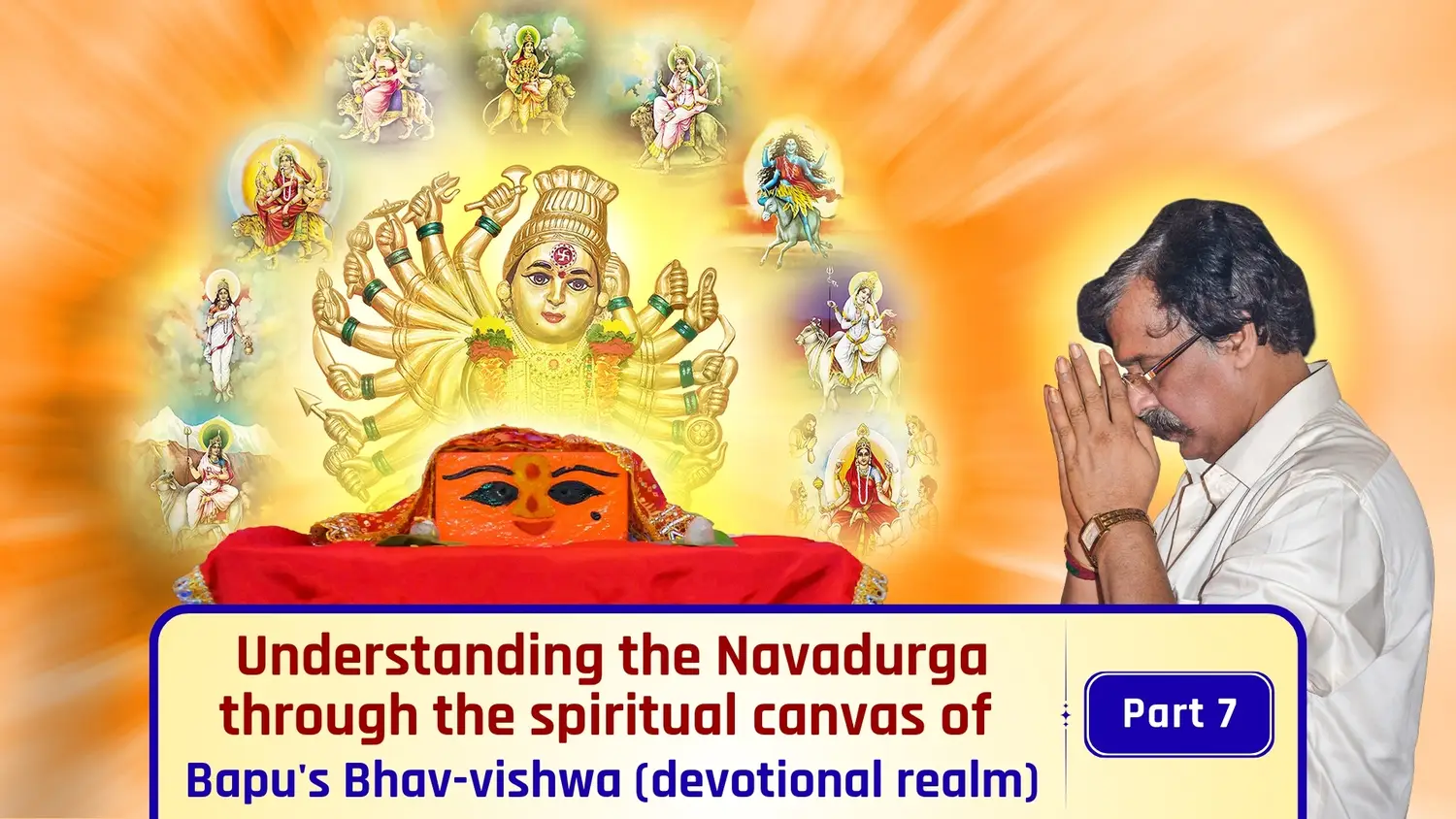
हिंदी मराठी ગુજરાતી বাংলা తెలుగు ಕನ್ನಡ മലയാളം தமிழ்
Reference: From the editorials numbered 1392 and 1393 in the Tulsipatra series of the daily ‘Pratyaksha’ by Sadguru Shree Aniruddha Bapu.
In Tulsipatra – 1392, Sadguru Shree Aniruddha Bapu writes:
All those present were overwhelmed after hearing from the mouth of the Adimata seated on the throne of Manidweepa, the glory of Madhura Bhakti and the secret of the three incarnations—Parashuram, Shreeram, and Shreekrishna, that would take place in the Treta and Dwapar yugas for the growth of this very Madhura Bhakti.
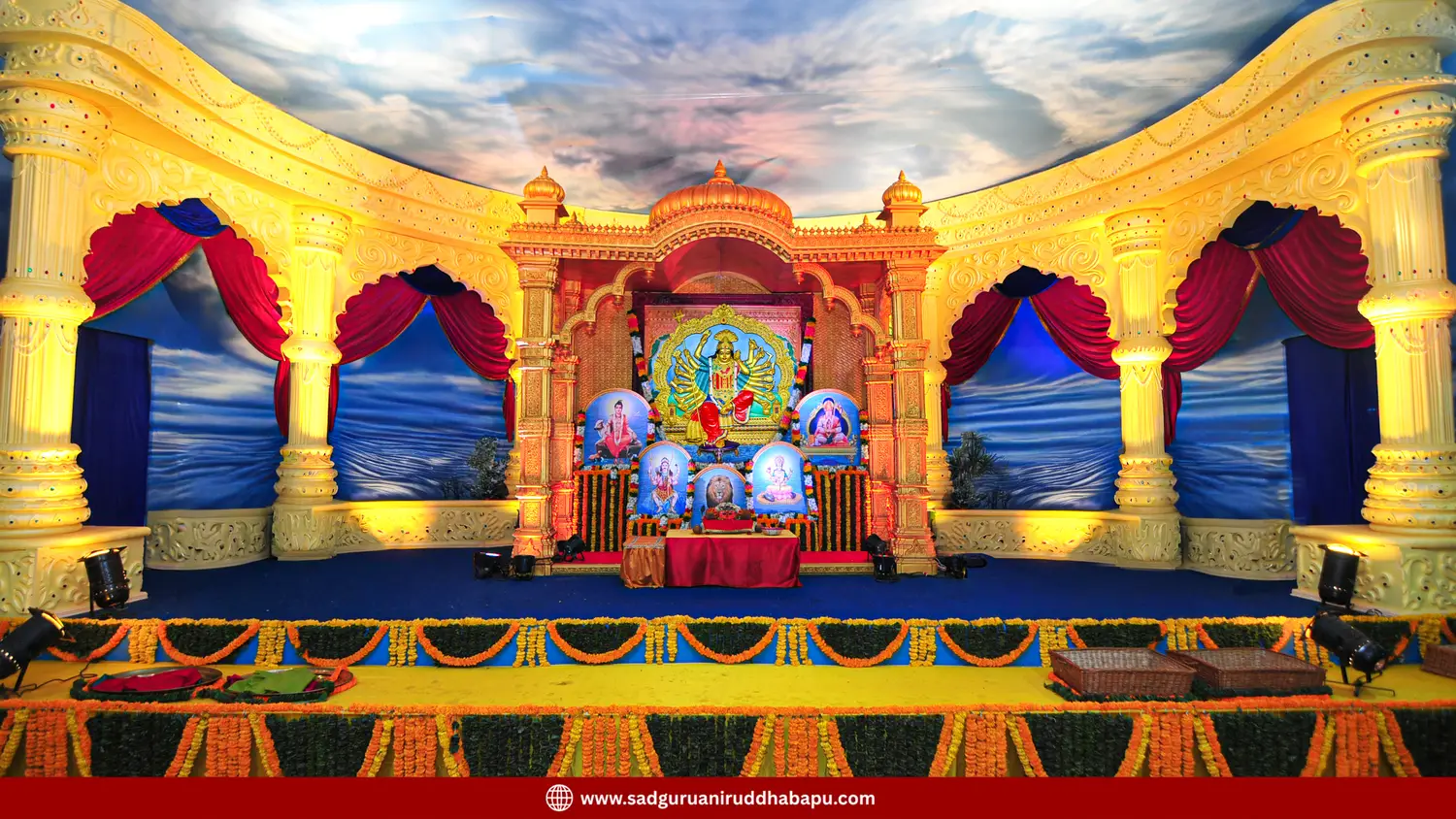
When they heard that Brahmarshi Kat and Brahmavadini Kanti would themselves give birth to the Adimata, and Brahmarshi Katyayan and Brahmavadini Kruti would give birth to ShreeRam and ShreeKrishna respectively, everyone gathered around these four and began to express their joy.
Mount Kailash was filled with waves of happiness and excitement. Knowing what great fortune awaited them, what they were about to see and experience, all the sages and attendants(ganas) of Shiva began to exclaim, “Ambadnya! Ambadnya! Blessed! Blessed!”
The feeling of Ambadnyata (grateful awareness of the Mother’s grace) in the hearts of the attendants of Shiva grew so intense that it took the form of a pure white brick (ishtika).
Each Shivagana (attendantsof Shiva) found such a white brick in his hand. They were amazed and looked towards the Shiv-Rishi Tumburu, seeking explanation.
Shiv-Rishi Tumburu, with the permission of the Adimata, lovingly said to them,
“O attendants of Shiva! The Ambadnyata within your hearts has taken a tangible form as this ishtika. Place this brick lovingly upon your head.”
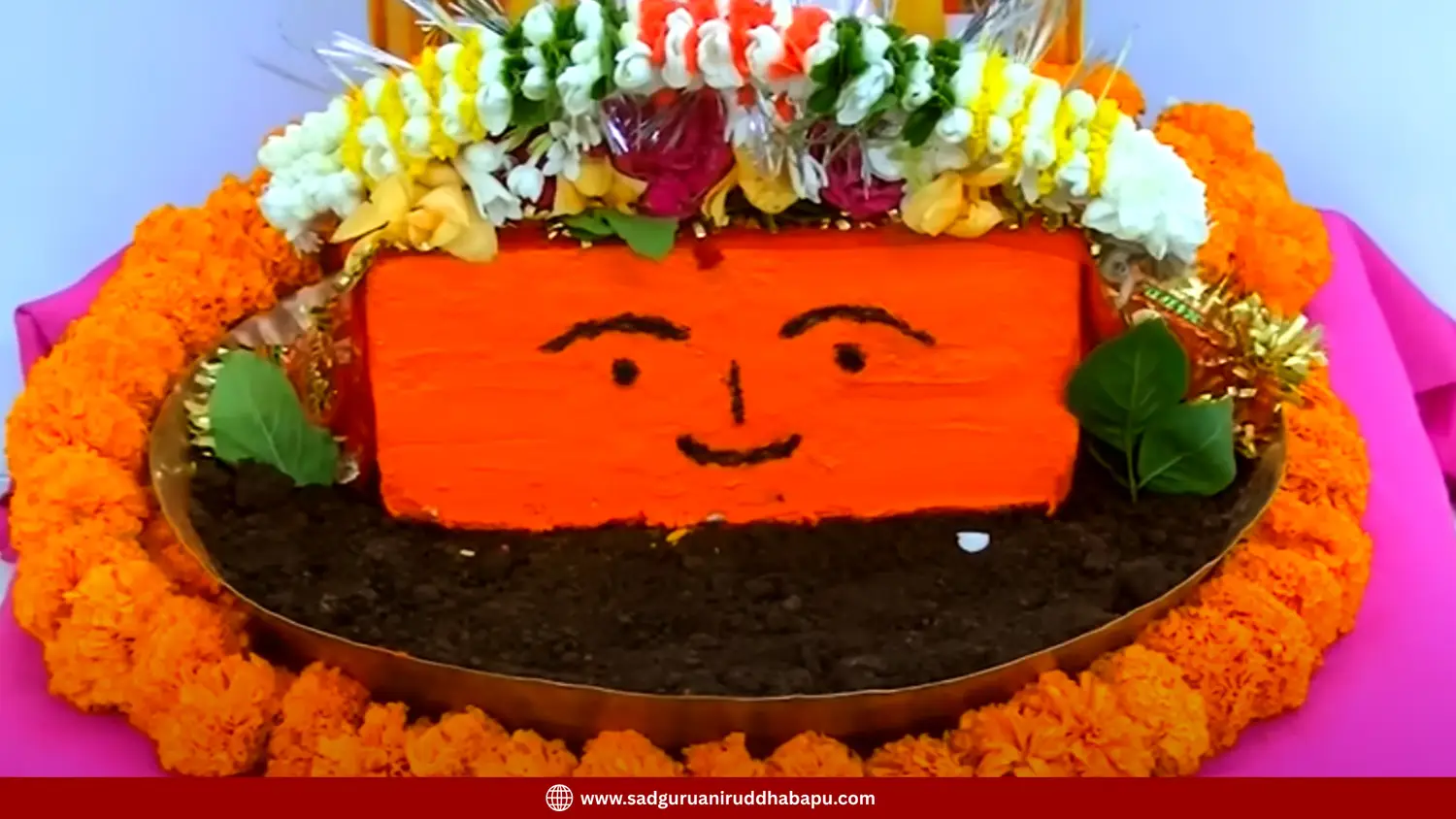
However, even Tumburu himself did not know what was to be done with the brick. At that moment, the sixth Navadurga, Bhagavati Katyayani, stepped forward, offered obeisance to the Adimata, and addressing the Shivaganas said:
“O beloved ones! The brick in your hand is the embodiment of Ambadnyata born out of attaining Madhurā Bhakti. The source of this Madhurā Bhakti is the Adimata Chandikā herself.
And the Ambadnyata within us all has manifested from the Mother’s own Dattadnyata (gratefulness towards Dattaguru) (as described in the Matruvatsalya Upanishad.)
Hence, O Shraddhavans, place these pure white ishtika upon the water below the right foot of the Adimata, upon which Her foot rests, as Her sacred Charaṇapiṭha (foot pedestal).”
At these words, all the Shivaganas, carrying their ishtikas on their heads, rushed to the Mother’s lotus feet and began to offer the ishtikas.
All the ishtikas came together and merged into one single ishtika, seen floating under the right foot of the Adimata.
Now, the color of this unified Ambadnyatā ishtika had turned saffron.
Then, Shringiprasād and Bhringiprasād arrived near the Mother’s feet with their own ishtikas upon their heads. As they tried to lift their ishtikas to offer them at Her feet, both found that their ishtikas had suddenly become so heavy that they could not lift them even slightly.
With deep anguish, they prayed to their eight-year-old deity, Trivikram:
“O Bhagwan Trivikram! What mistake have we committed that the Adimata refuses to accept our ishtikas?”
Upon hearing this heartfelt question, the Adimata gestured to Her son Trivikram to approach them. Descending from Her lap, the One-faced Bhagwan Trivikram shed His child form and stood beside the two, placing His hands upon their shoulders.
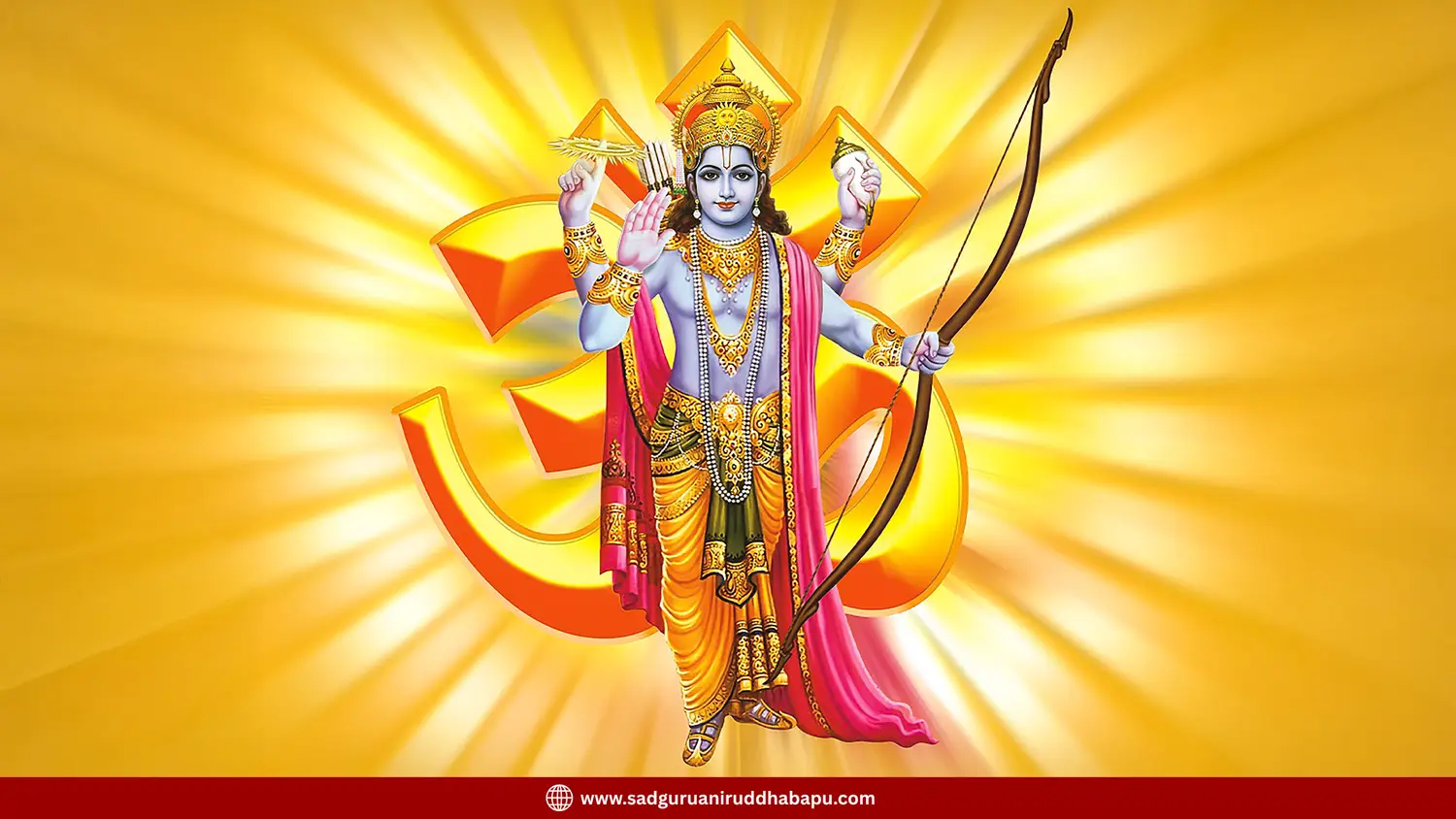
With His touch, their ishtikas began to grow lighter. Yet, with a mere glance, Trivikram signaled them not to offer their ishtikas just yet.
At that very moment, from within Katyayani, the sixth Navadurga, emerged the other eight Navadurgas.
All nine goddesses together placed their hands upon both the ishtikas, and instantly the two ishtikas merged into one.
Then Bhagwan Trivikram instructed the two to place this single ishtika upon the Charaṇapiṭha of the Adimata.
Now the ishtika had become light.
As soon as it was placed at the lotus feet of the Mother, Bhagwan Trivikram applied vermilion (shendur) to it.
While the ishtika still rested beneath the Mother’s lotus feet, He asked for the kohl (kajal) from the eyes of each of the nine Navadurgas and drew upon it the face of the Adimata.
Then, one by one, each of the nine Navadurgas offered a portion of their open end of a saree as a “Chunari” to adorn the very face of the Mother that had been drawn.
Now, folding His hands, Bhagwan Trivikram stood before His Mother and prayed silently.
Adorning a smiling face, the Adimata began to speak:
“During the Ashwin Navarātri or on any other auspicious and holy day, when a devotee creates such an ishtika and performs its worship with devotion, that offering shall directly reach Me through My son Trivikram.
For, from Maharshi Shringi and Maharshi Bhringi down to Shringiprasad and Bhringiprassd, these two did not desire to bear the immense load of merit (punya) earned from their arduous journey.
That merit, through their Ambadnyata, flowed from their heads into these ishtikas. Hence, the ishtika had become extremely heavy.
When that boundless merit was offered at My lotus feet, I accepted this ishtika, as urged by My son as a sacred symbol of My own worshipful form, as a Pujan Pratik (symbol of worship), and as a Navadurga Pratik (symbol of the Nine Durgas).
So be it.”
Upon hearing this, Bhagwan Trivikram lifted the ishtika resting under the Mother’s feet, known henceforth as the Chandika Paṣhan and began to worship it Himself.
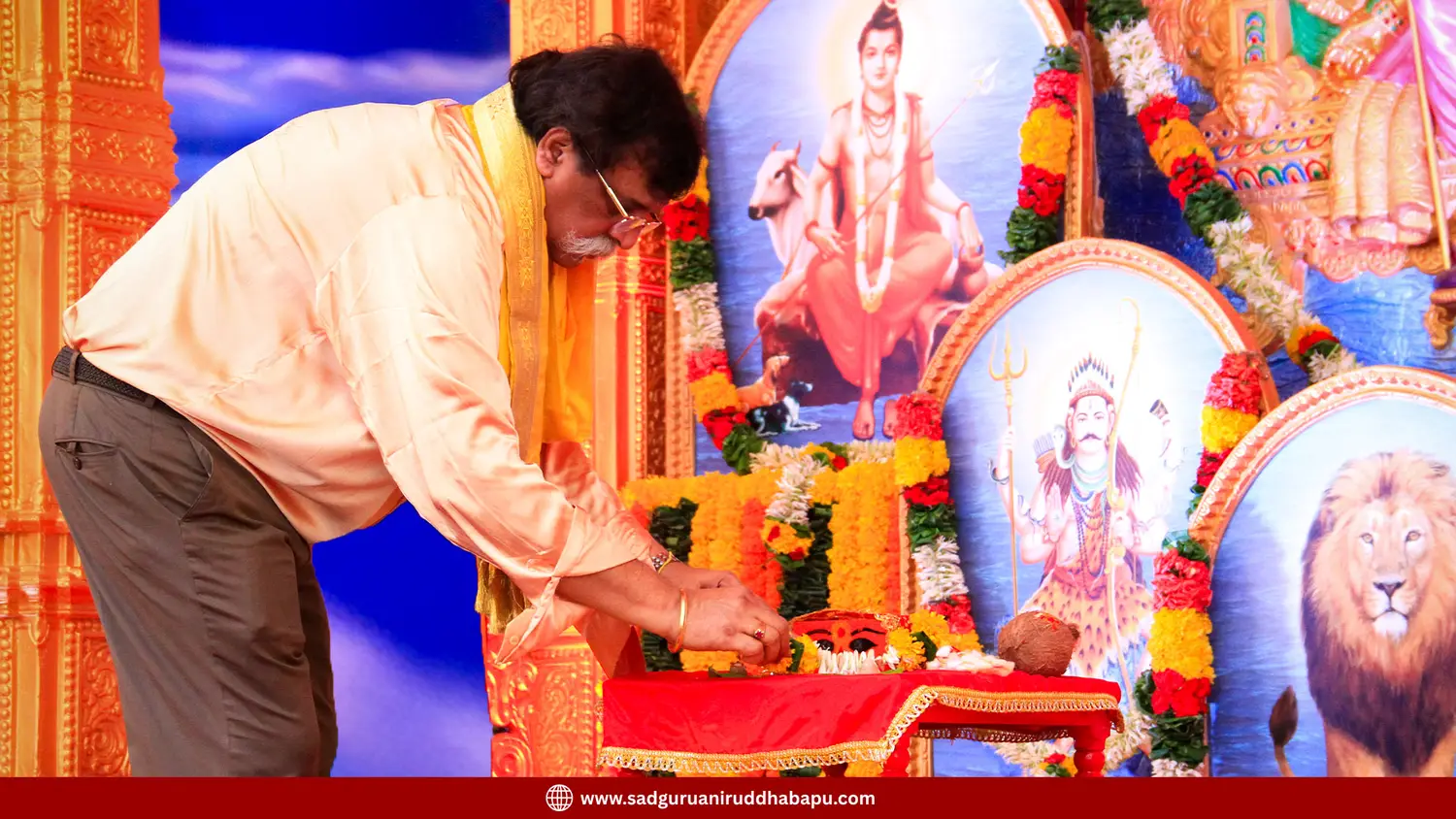
In Tulsipatra – 1393, Sadguru Shree Aniruddha Bapu writes:
Bhagwan Trivikram placed the sacred ishtika, in other words, the Matrupashan, before him and began worshipping it with a calm and peaceful mind.
He started chanting the mantras of the nine goddesses one by one. As he uttered “Om Shailaputryai Namah” up to “Om Siddhidatryai Namah,” the Adimata said, “Navaratri Pratipada.” Thereafter, each time Trivikram pronounced the next mantra in the same sequence, the Mother announced the corresponding day — “Navaratri Dwitiya … Navaratri Navami.”
Thus, when the worship of Navaratri was completed, Bhagwan Trivikram presented that ChandikaPashan to Bhaktamata Parvati, who is the original form of the nine goddesses.
As soon as it reached her hands, that ChandikaPashan transformed into the bangles on her wrists and the beautiful necklace (Mohanmaal) around her neck.
That necklace had nine layers.
All the sages and Shivaganas now understood the true essence of Navaratri worship.
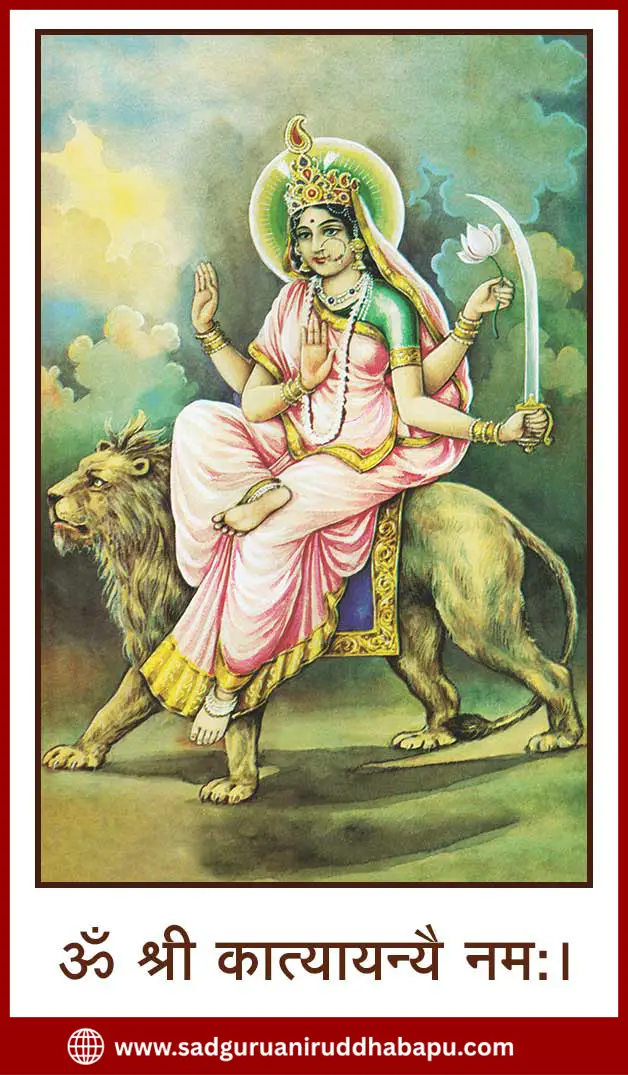
After this, all the nine goddesses once again merged into the sixth goddess, Katyayani.
Then Bhagwan Trivikram placed his hands upon the head of the Shiv-Rishi Tumburu and returned to his steadfast seat in the form of an eight-year-old child.
At that moment, Shiv-Rishi Tumburu offered obeisance to the sixth goddess, Katyayani, and began to speak:
“O dear ones, this sixth goddess Katyayani, the presiding deity of the eleventh and twelfth steps of the Shambhavi Vidya has revealed before us extraordinary and marvellous happenings.
The reason for this lies in her divine functions. Below mentioned are six principle functions of Goddess Katyayani.
- Goddess Katyayani awakens in the hearts of Shraddhavans the pure feelings of morality, compassion, and mercy. She strengthens their courage, ensuring that it never turns into cruelty or unrighteousness.
Because of this, a Shraddhavan belonging to the Chandikakul, no matter how brave, powerful, or victorious he may be, never becomes a demon. - In worldly life, Goddess Katyayani grants right understanding and right action to Shraddhavans parents for the protection of their children.
- Goddess Katyayani continually increases the feeling of ‘Ambadnya’ in the hearts of Shraddhavans, and through it, she strengthens their bond with Sadguru Trivikram.
- Goddess Katyayani blesses the homes of Shraddhavans so that peace and happiness dwell there.
- Goddess Katyayani enables Shraddhavans to recognize their beneficial adversaries.
- When the enemies of the Shraddhavans of the Chandikakul begin to gain strength, Goddess Katyayani herself becomes firmly established in deep meditation and invokes the seventh goddess, Kalaratri.”
After saying this, Shiv-Rishi Tumburu bowed his head at the lotus feet of Goddess Katyayani and prayed, “May you always keep me Ambadnya.”
And, at that moment, Goddess Katyayani became invisible, and suddenly pitch darkness spread everywhere.
Even the Adimata concealed her own radiance in that darkness.
All the sages and Shivganas present there were filled with eager anticipation, wondering, “What is going to happen next? What will we witness? How fortunate we are!”
Suddenly, in that darkness, millions of lightning flashes began to sparkle and gradually began to rumble.
In an instant, in the light of those lightning streaks, the seventh goddess, Kalaratri, became clearly visible.
Goddess Kalaratri was thousands of times darker than darkness itself, yet she was clearly visible even within it.
She had three eyes, and each of those eyes was as vast as the universe.
From her eyes emanated an extraordinary and blazing radiance, yet no one present felt its heat.
From her nostrils came forth streams of fierce flames like fiery arrows, yet none of them touched or harmed the Shraddhavans.
Around her neck were garlands of lightning.
Goddess Kalaratri had four arms. Her two right hands were in the gestures of ‘protection’(Abhaymudra) and ‘blessing’ (Varadmudra). In her upper left hand, she held an iron weapon studded with spikes (Kantakastra), and in her lower left hand she held a 'Chandratalwar,' a sword that was a combination of a dagger and a sword.
Goddess Kalaratri was seated upon a gigantic and ferocious donkey.
Thus, as this extremely fearsome form of the seventh goddess, Kalaratri, manifested, all the sages and divine women began to sing and dance with joy, praising her in unison — “Victory, victory to the auspicious Kalaratri.”
Not a single Shraddhavan felt even the slightest fear of her form.
(As explained by Sadguru Shree Aniruddha Bapu, the detailed method of Navaratri poojan— that is, the poojan of the sacred Ambadnya-ishtika during Navaratri — was published on my blog on Thursday, 14 September 2017. Here is the link: https://sadguruaniruddhabapu.com/post/navaratri-poojan-ashwin-marathi )
